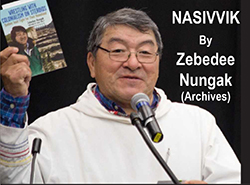
NASIVVIK By Zebedee Nungak,
Windspeaker Columnist; Archives 2003
Nasivvik is an Inuktitut word that means vantage point. It can be a height of land, a hummock of ice, or any place of elevation that affords observers a clear view of their surroundings to make good observations.
The first generation of Inuit who experienced formal education learned some amazing things.
Among them, the history of Canada taught from the Qallunaat (White man's) point of view.
In this version, Qallunaat, who pioneered the European conquest of North America, are highly-regarded, some even revered, as discoverers and founders of unknown lands. They live in history books as courageous pioneers and trailblazers who opened up a continent.
I will forever be able to recite by rote what I learned of history among the Qallunaat—Jacques Cartier's "discovery" of the St. Lawrence River in 1535; the establishment of the first French colony in Quebec in 1608 under Samuel de Champlain; and Sir John A. Macdonald becoming Canada's first prime minister in 1867.
These people are honored to the present day by having their names given to bridges, streets, parks, lakes, buildings, colleges, and universities.
Qallunaat may not be superior to the human beings they found in the New World, but not many Aboriginals they encountered appear by name in the history books. This signifies their lesser importance in events that shaped Canada.
In these versions of history, Qallunaat always appear as the bosses of the lands they came upon. How they attained such status should be exposed, studied, analyzed and known by the younger generations of Inuit.
The collective historical self-knowledge of Inuit has to be made complete and accurate from the Inuit perspective. The origins, livelihoods, and wanderings of our ancestors are true wonders, which must be made thoroughly familiar to our children and grandchildren.
To outsiders, Arctic life looked like a savage and primitive existence. In fact, it was life in full, ingenious, tune with the Arctic environment and its resources, with its cycles of plenty and famine.
Throughout history, Inuit provided vital knowledge and assistance to outsiders' endeavors in the Arctic. Whalers, explorers, missionaries, traders, police forces and government officials all have episodes in their stories where they have to acknowledge the contributions of Inuit as central to the success of their enterprises.
Furthermore, Inuit were not mere spectators while everybody else made history. They skirmished with Martin Frobisher, and Henry Hudson's crew. They guided, hunted, and drew maps for explorers. They supplied dog food and indispensable survival expertise to policemen.
Compiling history from the point of view of Canadian Inuit can likely keep several historians busy for a good length of time, because there are so many rich sources on the subject to tap into and sort out.
The facts of early Arctic habitation are explained easily enough by the respectable body of work that exists in archeology, thanks to people known to Inuit as Tuniqtaniaqtiit (those who dig for evidences of Tuniit).
A fascinating period of Arctic history is the 350-year span of time from Martin Frobisher's trip to southern Baffin Island in 1576 to the time of the establishment of trading posts in the early 1900s, during which there are events of contact to confirm and to connect.
There are hostilities between Inuit and Qallunaat to study, misunderstandings to analyze, and profound changes in material culture to examine. There are Inuit names in history to verify, and correct.
During the most important period of the great transitions in Inuit life from the nomadic to the permanent townspeople eras, there's the evolution of the relationships between governments and the governed to be detailed. There are many painful episodes of people being forced to relocate from their ancestral lands and surroundings, which have had lasting effects on families and communities.
Many written historical accounts dealing with Inuit suffer from having been written by outsiders entirely unfamiliar with Inuit ways. Premised upon defective understanding, their take on history was distorted, incomplete, and not entirely accurate.
Nonetheless, records from every institution that has operated in the Arctic have to be utilized in compiling such a history. Volumes of books, reports, and journals by Qallunaat, who were in the Arctic over the years, can actually be great sources of faithfully recorded observations in words and photographs of how things were at specific times and places. To this end, I keep discovering obscure books, which provide nuggets of truth and insight.
Oral traditional knowledge possessed by Inuit Elders is another invaluable source of Inuit history. Our oldest people were born in their traditional lands, and spent much of their lives there, living and breathing this important period in history. Much can also be found preserved in audio recordings, and in print, in various museums, where great collections of Inuit cultural material are stored.
An Inuit Historical Commission is needed to supervise the research and compilation of history, according to Inuit. Establishing such a body, and connecting it to an appropriate university, shouldn't be difficult.
History cannot be rewritten, but it can and should be corrected.
